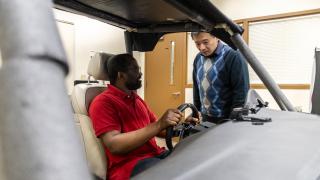
Have you been in a business meeting where someone tries to talk louder to compensate for a language barrier? Or seen long blocks of text or acronyms, instead of clear concise wording or graphics, used in a presentation to a multinational audience?
Lecturer Jill Plavcan has. And she wants to prepare UM-Dearborn students to avoid these types of mistakes and to be effective project managers by understanding cultural difference in the global workplace and managing global projects. Not only is it respectful, it’s also good business.
“It’s about communication, communication, communication. This is more than language. It’s creating trust and an understanding so you can reduce anxieties. It’s making sure needs and expectations are clear and met. This class discusses is how to do that—and how to build high performance global teams,” said Plavcan, who has a fulltime position at Ford Motor Company responsible for global planning and strategy for technology and features development.
Plavcan created the campus course IMSE 517: Global Project Management four years ago, using her 20-plus years of experience in project management at an international level.
She originally came to campus with the intention of teaching a lean manufacturing course—but Industrial and Manufacturing Systems Engineering Chairman Armen Zakarian had another idea.
“He looked at my experience and asked if I’d be interested in teaching a graduate level course on project management at a multinational level. I definitely was,” she said. “The students have responded well too—our students realize it is important to successfully navigate communication across cultures.” There are 67 students this semester in her campus and online sections combined.
The course has no textbook—materials are refreshed and updated each semester and include lively discussion online and in class, exchange of ideas, sharing of experiences and a final project where groups of students work together to create a business plan for an organization in another country.
When doing this, students learn about how other countries view time and urgency, experience communication style differences, understand difference in work practices and regulations, and see which negotiation tactics were the most successful. Plavcan said it is a real world step into international business relationships—but with the opportunity to come to class first to discuss and evaluate communication methods prior to using them.
When choosing his final project, program and project management graduate student George Sammit—who lives in Texas and takes the distance learning course—said his group researched working with Canada, specifically the Gordie Howe Bridge Project.
After discussions with officials on the Windsor-Detroit Bridge Authority and other groups associated with the project, his group wrote a case study.
“We chose Canada because many Americans don’t think of it as being much different, but there are pretty distinct cultural differences between the two,” said Sammit, saying one thing he noticed is that law requires that federal information and documents need to be in both English and French, giving equal status to the two languages.
Sammit, who works with global partners in his position as a software engineer, said he admired how the Canadian side handled the U.S. opposition of the bridge—through transparency and attending town hall meetings.
“To get information out there they did a grassroots effort, something many Americans value,” he said. “I think that was a very good relationship building move on their part.”
Sammit said Plavcan’s course is required in his program, but he’d be interested in taking it even if it wasn’t.
“Professor Plavcan’s a very interactive teacher. And this is coming from someone who is taking it online. Even from a distance you can tell that she really cares about this,” said Sammit, who work with partners from India and Mexico and said this class has given him ‘a-ha moments.’ “Communicating, especially across cultures, is not a cut-and-dried thing. It’s not making a decision tree using statistics or a cost analysis. She gives us tools and suggestions on how to communicate with global partners effectively; she’s making us aware. Since globalism is the direction the world is headed in, this information plays an important role in business education.”



